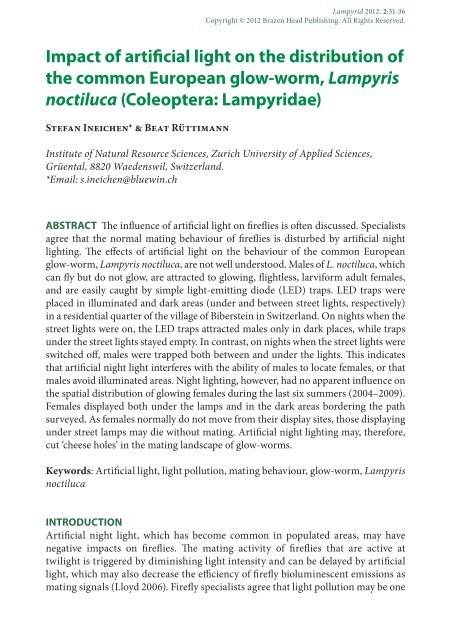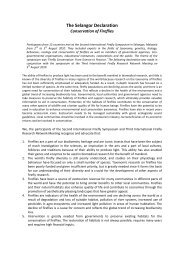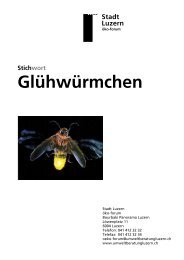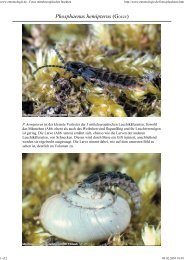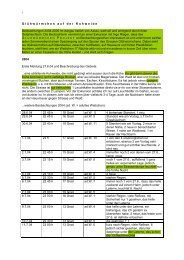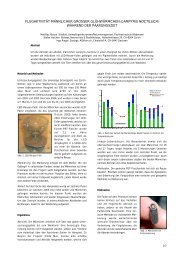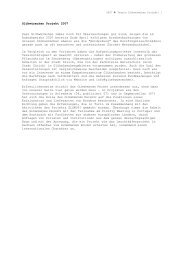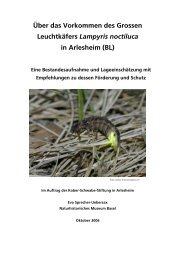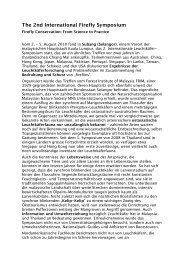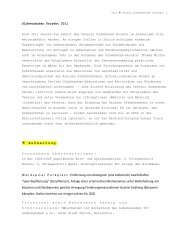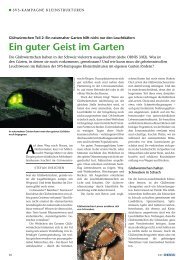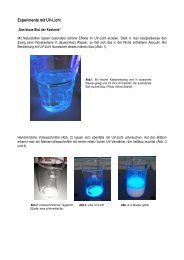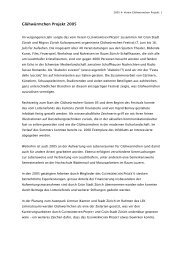Impact of artificial light on the distribution of the ... - Glühwürmchen
Impact of artificial light on the distribution of the ... - Glühwürmchen
Impact of artificial light on the distribution of the ... - Glühwürmchen
Create successful ePaper yourself
Turn your PDF publications into a flip-book with our unique Google optimized e-Paper software.
Lampyrid 2012. 2:31-36<br />
Copyright © 2012 Brazen Head Publishing. All Rights Reserved.<br />
<str<strong>on</strong>g>Impact</str<strong>on</strong>g> <str<strong>on</strong>g>of</str<strong>on</strong>g> <str<strong>on</strong>g>artificial</str<strong>on</strong>g> <str<strong>on</strong>g>light</str<strong>on</strong>g> <strong>on</strong> <strong>the</strong> distributi<strong>on</strong> <str<strong>on</strong>g>of</str<strong>on</strong>g><br />
<strong>the</strong> comm<strong>on</strong> European glow-worm, Lampyris<br />
noctiluca (Coleoptera: Lampyridae)<br />
Stefan Ineichen* & Beat Rüttimann<br />
Institute <str<strong>on</strong>g>of</str<strong>on</strong>g> Natural Resource Sciences, Zurich University <str<strong>on</strong>g>of</str<strong>on</strong>g> Applied Sciences,<br />
Grüental, 8820 Waedenswil, Switzerland.<br />
*Email: s.ineichen@bluewin.ch<br />
Abstract The influence <str<strong>on</strong>g>of</str<strong>on</strong>g> <str<strong>on</strong>g>artificial</str<strong>on</strong>g> <str<strong>on</strong>g>light</str<strong>on</strong>g> <strong>on</strong> fireflies is <str<strong>on</strong>g>of</str<strong>on</strong>g>ten discussed. Specialists<br />
agree that <strong>the</strong> normal mating behaviour <str<strong>on</strong>g>of</str<strong>on</strong>g> fireflies is disturbed by <str<strong>on</strong>g>artificial</str<strong>on</strong>g> night<br />
<str<strong>on</strong>g>light</str<strong>on</strong>g>ing. The effects <str<strong>on</strong>g>of</str<strong>on</strong>g> <str<strong>on</strong>g>artificial</str<strong>on</strong>g> <str<strong>on</strong>g>light</str<strong>on</strong>g> <strong>on</strong> <strong>the</strong> behaviour <str<strong>on</strong>g>of</str<strong>on</strong>g> <strong>the</strong> comm<strong>on</strong> European<br />
glow-worm, Lampyris noctiluca, are not well understood. Males <str<strong>on</strong>g>of</str<strong>on</strong>g> L. noctiluca, which<br />
can fly but do not glow, are attracted to glowing, f<str<strong>on</strong>g>light</str<strong>on</strong>g>less, larviform adult females,<br />
and are easily caught by simple <str<strong>on</strong>g>light</str<strong>on</strong>g>-emitting diode (LED) traps. LED traps were<br />
placed in illuminated and dark areas (under and between street <str<strong>on</strong>g>light</str<strong>on</strong>g>s, respectively)<br />
in a residential quarter <str<strong>on</strong>g>of</str<strong>on</strong>g> <strong>the</strong> village <str<strong>on</strong>g>of</str<strong>on</strong>g> Biberstein in Switzerland. On nights when <strong>the</strong><br />
street <str<strong>on</strong>g>light</str<strong>on</strong>g>s were <strong>on</strong>, <strong>the</strong> LED traps attracted males <strong>on</strong>ly in dark places, while traps<br />
under <strong>the</strong> street <str<strong>on</strong>g>light</str<strong>on</strong>g>s stayed empty. In c<strong>on</strong>trast, <strong>on</strong> nights when <strong>the</strong> street <str<strong>on</strong>g>light</str<strong>on</strong>g>s were<br />
switched <str<strong>on</strong>g>of</str<strong>on</strong>g>f, males were trapped both between and under <strong>the</strong> <str<strong>on</strong>g>light</str<strong>on</strong>g>s. This indicates<br />
that <str<strong>on</strong>g>artificial</str<strong>on</strong>g> night <str<strong>on</strong>g>light</str<strong>on</strong>g> interferes with <strong>the</strong> ability <str<strong>on</strong>g>of</str<strong>on</strong>g> males to locate females, or that<br />
males avoid illuminated areas. Night <str<strong>on</strong>g>light</str<strong>on</strong>g>ing, however, had no apparent influence <strong>on</strong><br />
<strong>the</strong> spatial distributi<strong>on</strong> <str<strong>on</strong>g>of</str<strong>on</strong>g> glowing females during <strong>the</strong> last six summers (2004–2009).<br />
Females displayed both under <strong>the</strong> lamps and in <strong>the</strong> dark areas bordering <strong>the</strong> path<br />
surveyed. As females normally do not move from <strong>the</strong>ir display sites, those displaying<br />
under street lamps may die without mating. Artificial night <str<strong>on</strong>g>light</str<strong>on</strong>g>ing may, <strong>the</strong>refore,<br />
cut ‘cheese holes’ in <strong>the</strong> mating landscape <str<strong>on</strong>g>of</str<strong>on</strong>g> glow-worms.<br />
Keywords: Artificial <str<strong>on</strong>g>light</str<strong>on</strong>g>, <str<strong>on</strong>g>light</str<strong>on</strong>g> polluti<strong>on</strong>, mating behaviour, glow-worm, Lampyris<br />
noctiluca<br />
Introducti<strong>on</strong><br />
Artificial night <str<strong>on</strong>g>light</str<strong>on</strong>g>, which has become comm<strong>on</strong> in populated areas, may have<br />
negative impacts <strong>on</strong> fireflies. The mating activity <str<strong>on</strong>g>of</str<strong>on</strong>g> fireflies that are active at<br />
twi<str<strong>on</strong>g>light</str<strong>on</strong>g> is triggered by diminishing <str<strong>on</strong>g>light</str<strong>on</strong>g> intensity and can be delayed by <str<strong>on</strong>g>artificial</str<strong>on</strong>g><br />
<str<strong>on</strong>g>light</str<strong>on</strong>g>, which may also decrease <strong>the</strong> efficiency <str<strong>on</strong>g>of</str<strong>on</strong>g> firefly bioluminescent emissi<strong>on</strong>s as<br />
mating signals (Lloyd 2006). Firefly specialists agree that <str<strong>on</strong>g>light</str<strong>on</strong>g> polluti<strong>on</strong> may be <strong>on</strong>e
32 Ineichen & Rüttimann<br />
<str<strong>on</strong>g>of</str<strong>on</strong>g> <strong>the</strong> reas<strong>on</strong>s for a decline in firefly<br />
populati<strong>on</strong>s around <strong>the</strong> world, but<br />
few studies are available to support<br />
this hypo<strong>the</strong>sis. A laboratory study<br />
<str<strong>on</strong>g>of</str<strong>on</strong>g> Luciola aquatilis in Thailand<br />
noted that <str<strong>on</strong>g>artificial</str<strong>on</strong>g> <str<strong>on</strong>g>light</str<strong>on</strong>g> c<strong>on</strong>diti<strong>on</strong>s<br />
prol<strong>on</strong>ged courtship and dorsal<br />
mounting behavior, thus leng<strong>the</strong>ning<br />
mating time (Thancharoen et<br />
al. 2009). No field studies have been<br />
published <strong>on</strong> <strong>the</strong> influence <str<strong>on</strong>g>of</str<strong>on</strong>g> <str<strong>on</strong>g>artificial</str<strong>on</strong>g><br />
<str<strong>on</strong>g>light</str<strong>on</strong>g> <strong>on</strong> firefly behaviour.<br />
The comm<strong>on</strong> European glowworm,<br />
Lampyris noctiluca, which<br />
is <strong>the</strong> subject <str<strong>on</strong>g>of</str<strong>on</strong>g> this study, is a<br />
widespread species with a range<br />
extending from Portugal and Britain<br />
in <strong>the</strong> west, across Europe and Asia<br />
to China in <strong>the</strong> east (Tyler 2002).<br />
During summertime in Switzerland,<br />
and especially in June and July, <strong>the</strong><br />
f<str<strong>on</strong>g>light</str<strong>on</strong>g>less larviform adult females<br />
begin to glow so<strong>on</strong> after dusk. They<br />
<str<strong>on</strong>g>of</str<strong>on</strong>g>ten display <strong>on</strong> low vegetati<strong>on</strong> in<br />
open spaces, for example al<strong>on</strong>g<br />
waysides, forest edges and grasslands.<br />
With <strong>the</strong>ir bioluminescent signal,<br />
<strong>the</strong> females attract males, which fly<br />
in obstacle-free z<strong>on</strong>es in search <str<strong>on</strong>g>of</str<strong>on</strong>g><br />
a mate (Ineichen 2004). So<strong>on</strong> after<br />
mating, females stop glowing. The<br />
same individual females <str<strong>on</strong>g>of</str<strong>on</strong>g> L. noctiluca<br />
have been found glowing night<br />
after night under street lamps and in<br />
o<strong>the</strong>r illuminated sites for up to 17<br />
nights (Ursula Moor, pers. comm. in<br />
2009). The objective <str<strong>on</strong>g>of</str<strong>on</strong>g> this study was<br />
to determine <strong>the</strong> effect <str<strong>on</strong>g>of</str<strong>on</strong>g> <str<strong>on</strong>g>artificial</str<strong>on</strong>g><br />
night <str<strong>on</strong>g>light</str<strong>on</strong>g> <strong>on</strong> <strong>the</strong> ability L. noctiluca<br />
females to attract males, using<br />
simulated female glows emitted by<br />
LED (<str<strong>on</strong>g>light</str<strong>on</strong>g>-emitting diode) traps.<br />
Figure 1 Map <str<strong>on</strong>g>of</str<strong>on</strong>g> <strong>the</strong> residential area in Biberstein,<br />
Switzerland where Lampyris noctiluca was<br />
sampled. LED traps targeting males were placed<br />
al<strong>on</strong>g 210 m <str<strong>on</strong>g>of</str<strong>on</strong>g> a pedestrian lane illuminated at<br />
night with street lamps. Yellow spots mark each<br />
trap. Red circles show <strong>the</strong> locati<strong>on</strong>s <str<strong>on</strong>g>of</str<strong>on</strong>g> lamps. A<br />
small creek (not visible in <strong>the</strong> map) flows <strong>on</strong> <strong>the</strong><br />
right side <str<strong>on</strong>g>of</str<strong>on</strong>g> <strong>the</strong> lane and empties into a p<strong>on</strong>d<br />
indicated by <strong>the</strong> white arrow. The red box marks<br />
<strong>the</strong> area where <strong>the</strong> distributi<strong>on</strong> <str<strong>on</strong>g>of</str<strong>on</strong>g> females was<br />
examined in 2007.<br />
Lampyrid Volume 2 (2012)
<str<strong>on</strong>g>Impact</str<strong>on</strong>g> <str<strong>on</strong>g>of</str<strong>on</strong>g> <str<strong>on</strong>g>artificial</str<strong>on</strong>g> <str<strong>on</strong>g>light</str<strong>on</strong>g> <strong>on</strong> Glow-worm distributi<strong>on</strong> 33<br />
Methods<br />
The study was c<strong>on</strong>ducted al<strong>on</strong>g a 210 m secti<strong>on</strong> <str<strong>on</strong>g>of</str<strong>on</strong>g> a pedestrian lane (midpoint <str<strong>on</strong>g>of</str<strong>on</strong>g><br />
lane 47°24’59”N, 8°05’07”E; Fig. 1) flanked by a creek, in <strong>the</strong> residential quarter<br />
<str<strong>on</strong>g>of</str<strong>on</strong>g> <strong>the</strong> village <str<strong>on</strong>g>of</str<strong>on</strong>g> Biberstein in Switzerland. Vegetati<strong>on</strong> bordering <strong>the</strong> path largely<br />
comprised grasses and small shrubs in a more or less open space.<br />
The positi<strong>on</strong>ing <str<strong>on</strong>g>of</str<strong>on</strong>g> five high pressure sodium street lamps al<strong>on</strong>g <strong>the</strong> lane resulted<br />
in alternating illuminated and dark areas beneath and between <strong>the</strong> lamps, respectively,<br />
which were used to investigate <strong>the</strong> effects <str<strong>on</strong>g>of</str<strong>on</strong>g> illuminance <strong>on</strong> <strong>the</strong> glow-worm.<br />
Male glow-worms were sampled using LED traps <strong>on</strong> 14 fair-wea<strong>the</strong>r nights between<br />
14 June and 7 July 2010. For three <str<strong>on</strong>g>of</str<strong>on</strong>g> <strong>the</strong> sampling nights (28 June, 1 and 4 July),<br />
<strong>the</strong> street lamps were switched <str<strong>on</strong>g>of</str<strong>on</strong>g>f. The LED traps, which are designed to simulate<br />
female glow behavior, have been established to be an effective method <str<strong>on</strong>g>of</str<strong>on</strong>g> sampling<br />
L. noctiluca males (Ineichen 2004; J. Tyler, pers. comm. in 2007). One LED trap<br />
was placed beneath each <str<strong>on</strong>g>of</str<strong>on</strong>g> <strong>the</strong> five street lamps (five illuminated areas), between<br />
<strong>the</strong> street lamps and at both ends <str<strong>on</strong>g>of</str<strong>on</strong>g> <strong>the</strong> lane (six dark areas) as shown in Fig. 2.<br />
The traps were operated between 10.00–11.15 pm, at <strong>the</strong> end <str<strong>on</strong>g>of</str<strong>on</strong>g> civil twi<str<strong>on</strong>g>light</str<strong>on</strong>g>, which<br />
occurred between 10.06–10.09 pm during <strong>the</strong> study period (sunsets took place<br />
between 9.26–9.29 pm). Trapped males were collected and put in a box and released<br />
at <strong>the</strong> end <str<strong>on</strong>g>of</str<strong>on</strong>g> each nightly sample. Illuminance at each trap site was measured using<br />
a luxmeter (Voltacraft® MS-1300).<br />
Figure 2 A LED trap (lower left) in an illuminated area beneath a street lamp. Ano<strong>the</strong>r trap (not<br />
visible) is placed in <strong>the</strong> dark area between this and <strong>the</strong> next street lamp in <strong>the</strong> distance.<br />
Lampyrid Volume 2 (2012)
34 Ineichen & Rüttimann<br />
The mean number <str<strong>on</strong>g>of</str<strong>on</strong>g> males caught per night was calculated for each trap, from<br />
<strong>the</strong> total catch over <strong>the</strong> 11 days when <strong>the</strong> lamps were turned <strong>on</strong> and, separately, for<br />
<strong>the</strong> three days when <strong>the</strong> lamps were switched <str<strong>on</strong>g>of</str<strong>on</strong>g>f. Means per trap were standardised<br />
for differences between periods when lamps were <strong>on</strong> and periods when lamps were<br />
<str<strong>on</strong>g>of</str<strong>on</strong>g>f by dividing <strong>the</strong>m by <strong>the</strong> overall mean for all traps when lamps were <strong>on</strong> and <str<strong>on</strong>g>of</str<strong>on</strong>g>f,<br />
respectively. Differences between standardised mean catches <strong>on</strong> lit and unlit nights<br />
were compared within traps placed under and between street lamps, and were<br />
tested for significance using paired t-tests. The results were examined in relati<strong>on</strong> to<br />
<strong>the</strong> spatial distributi<strong>on</strong> <str<strong>on</strong>g>of</str<strong>on</strong>g> glowing females in this area in 2007, using data provided<br />
by Ursula Moor.<br />
Results<br />
A total <str<strong>on</strong>g>of</str<strong>on</strong>g> 73 males were trapped throughout <strong>the</strong> 11 nights with illuminati<strong>on</strong> and<br />
all were exclusively in <strong>the</strong> dark areas (between lamps). Sampling <strong>on</strong> <strong>the</strong> three nights<br />
with no illuminati<strong>on</strong> yielded 58 males in total from traps both under and between<br />
lamps. One third <str<strong>on</strong>g>of</str<strong>on</strong>g> <strong>the</strong> combined total for all nights were captured between 10.30–<br />
10.45 pm. Standardised mean catches under lamps <strong>on</strong> lit and unlit nights differed<br />
significantly (paired t-test, T = –0.56, P = 0.005), with all catches occurring <strong>on</strong>ly <strong>on</strong><br />
unlit nights (Fig. 3). In n<strong>on</strong>-illuminated areas between lamps, standardised mean<br />
catches <strong>on</strong> lit and unlit nights were also significantly different (paired t-test, T =<br />
5.14, P < 0.005), with catches <strong>on</strong> lit nights exceeding catches <strong>on</strong> unlit nights (Fig. 3).<br />
On lit nights, illuminance beneath street lamps ranged from 46–64 lux, and at dark<br />
areas measured between 0.1–0.4 lux. During <strong>the</strong> three nights with no illuminati<strong>on</strong>,<br />
maximum illuminance was 0.4 lux.<br />
Figure 3 Standardised mean numbers (± S.E.) <str<strong>on</strong>g>of</str<strong>on</strong>g> L. noctiluca males captured per night per trap<br />
under and between street lamps when lamps were switched <strong>on</strong> or switched <str<strong>on</strong>g>of</str<strong>on</strong>g>f. Means with<br />
<strong>the</strong> same letter within trap placement categories were not significantly different (paired t-test,<br />
P ≤ 0.005).<br />
Lampyrid Volume 2 (2012)
<str<strong>on</strong>g>Impact</str<strong>on</strong>g> <str<strong>on</strong>g>of</str<strong>on</strong>g> <str<strong>on</strong>g>artificial</str<strong>on</strong>g> <str<strong>on</strong>g>light</str<strong>on</strong>g> <strong>on</strong> Glow-worm distributi<strong>on</strong> 35<br />
Records <str<strong>on</strong>g>of</str<strong>on</strong>g> <strong>the</strong> distributi<strong>on</strong><br />
<str<strong>on</strong>g>of</str<strong>on</strong>g> females in that area<br />
in 2007 (data courtesy <str<strong>on</strong>g>of</str<strong>on</strong>g><br />
Ursula Moor) revealed some<br />
clustering around <strong>the</strong> p<strong>on</strong>d<br />
and al<strong>on</strong>g some stretches<br />
<str<strong>on</strong>g>of</str<strong>on</strong>g> <strong>the</strong> path next to <strong>the</strong><br />
stream (Fig. 4). However this<br />
clustering appeared independent<br />
<str<strong>on</strong>g>of</str<strong>on</strong>g> <strong>the</strong> street lamps, i.e.,<br />
females were just as <str<strong>on</strong>g>of</str<strong>on</strong>g>ten<br />
found displaying near street<br />
lamps as in <strong>the</strong> dark areas<br />
between lamps. Fur<strong>the</strong>r, in<br />
our own study, we counted a<br />
total <str<strong>on</strong>g>of</str<strong>on</strong>g> 31 females displaying<br />
within 5 m <str<strong>on</strong>g>of</str<strong>on</strong>g> <strong>the</strong> street lamps<br />
and 76 females in <strong>the</strong> dark<br />
areas outside <strong>the</strong> 5 m radius<br />
<str<strong>on</strong>g>of</str<strong>on</strong>g> <strong>the</strong> c<strong>on</strong>es <str<strong>on</strong>g>of</str<strong>on</strong>g> <str<strong>on</strong>g>light</str<strong>on</strong>g>, although<br />
actual numbers in dark areas<br />
may be higher than what was<br />
counted because females stop<br />
glowing so<strong>on</strong> after mating,<br />
which in dark areas could<br />
take place earlier.<br />
Discussi<strong>on</strong><br />
The results clearly indicate<br />
that <str<strong>on</strong>g>artificial</str<strong>on</strong>g> night <str<strong>on</strong>g>light</str<strong>on</strong>g><br />
interferes with <strong>the</strong> ability <str<strong>on</strong>g>of</str<strong>on</strong>g><br />
L. noctiluca males to locate<br />
females, or that <strong>the</strong> males<br />
avoid illuminated areas. This<br />
Figure 4 Distributi<strong>on</strong> <str<strong>on</strong>g>of</str<strong>on</strong>g> L. noctiluca females al<strong>on</strong>g <strong>the</strong><br />
streets and pedestrian pathway <str<strong>on</strong>g>of</str<strong>on</strong>g> a residential area <str<strong>on</strong>g>of</str<strong>on</strong>g><br />
Birbenstein, Switzerland in <strong>the</strong> summer <str<strong>on</strong>g>of</str<strong>on</strong>g> 2007. Distributi<strong>on</strong><br />
map kindly provided by Ursula Moor.<br />
is evident from <strong>the</strong> absence <str<strong>on</strong>g>of</str<strong>on</strong>g> any males in traps under lamps but <strong>the</strong>ir presence<br />
between lamps <strong>on</strong> nights when <strong>the</strong> lamps were switched <strong>on</strong>, which c<strong>on</strong>trasted<br />
sharply with <strong>the</strong>ir presence in traps both under and between lamps <strong>on</strong> nights when<br />
<strong>the</strong> lamps were switched <str<strong>on</strong>g>of</str<strong>on</strong>g>f. Within <strong>the</strong> c<strong>on</strong>es <str<strong>on</strong>g>of</str<strong>on</strong>g> <str<strong>on</strong>g>light</str<strong>on</strong>g> produced by <strong>the</strong> lamps,<br />
illuminance was as much as 550 times greater than in areas <strong>on</strong>ly a few meters away.<br />
The high number <str<strong>on</strong>g>of</str<strong>on</strong>g> females displaying in illuminated areas suggests that female<br />
glow-worms do not base <strong>the</strong>ir selecti<strong>on</strong> <str<strong>on</strong>g>of</str<strong>on</strong>g> display sites <strong>on</strong> whe<strong>the</strong>r or not that area<br />
Lampyrid Volume 2 (2012)
36 Ineichen & Rüttimann<br />
is <str<strong>on</strong>g>artificial</str<strong>on</strong>g>ly illuminated at night. In <strong>the</strong>ir final instar, <strong>the</strong>y select <strong>the</strong>ir pupating and<br />
displaying sites during <strong>the</strong> day, preferring vegetati<strong>on</strong> that borders <strong>on</strong> open spaces<br />
(pers<strong>on</strong>al observati<strong>on</strong>s). The vegetati<strong>on</strong> provides refuge in <strong>the</strong> day and a perch from<br />
which <strong>the</strong>y can display and attract males after dusk. However, as adult females rarely<br />
move from <strong>the</strong>ir original selected site (Ursula Moor, pers. comm.), it is likely that<br />
females displaying beneath street lamps die without having mated.<br />
Artificial night <str<strong>on</strong>g>light</str<strong>on</strong>g> is, <strong>the</strong>refore, anticipated to carve “cheese holes” in <strong>the</strong><br />
mating landscape <str<strong>on</strong>g>of</str<strong>on</strong>g> glow-worms. Whe<strong>the</strong>r <strong>the</strong>se sinks where females die under<br />
street lamps without mating endanger <strong>the</strong> local populati<strong>on</strong> remains to be seen and<br />
warrants fur<strong>the</strong>r study. Although in some areas <str<strong>on</strong>g>artificial</str<strong>on</strong>g> night <str<strong>on</strong>g>light</str<strong>on</strong>g> may lead to<br />
<strong>the</strong> extincti<strong>on</strong> <str<strong>on</strong>g>of</str<strong>on</strong>g> comm<strong>on</strong> glow-worms, in <strong>the</strong> well-planned residential quarter <str<strong>on</strong>g>of</str<strong>on</strong>g><br />
Biberstein <strong>the</strong> populati<strong>on</strong> <str<strong>on</strong>g>of</str<strong>on</strong>g> L. noctiluca does not appear to be negatively affected<br />
at this time.<br />
AcknowledgEments<br />
We are very grateful to Ursula Moor who generously shared data ga<strong>the</strong>red from<br />
hundreds <str<strong>on</strong>g>of</str<strong>on</strong>g> her night walks recording female glow-worms. We also thank John<br />
Tyler for correcting <strong>the</strong> text and Raphaël De Cock and Ingo Rieger for reviewing an<br />
early draft <str<strong>on</strong>g>of</str<strong>on</strong>g> this paper.<br />
References<br />
Ineichen, S. (2004) Zur Raumnutzung v<strong>on</strong> Larven, Weibchen und Männchen des<br />
Grossen <strong>Glühwürmchen</strong>s Lampyris noctiluca. Mitteilungen der Entomologischen<br />
Gesellschaft Basel 53 111-122.<br />
Lloyd, J.E. (2006) Stray Light, Fireflies, and Fireflyers. In: Ecological C<strong>on</strong>sequences <str<strong>on</strong>g>of</str<strong>on</strong>g><br />
Artificial Night Lighting (Ed. by Rich, C. & L<strong>on</strong>gcore, T.), pp. 345-364. Washingt<strong>on</strong>:<br />
Island Press.<br />
Thancharoen, A., Baimai, V. & Branham, M.A. (2009) Luciola aquatilis, a new<br />
species <str<strong>on</strong>g>of</str<strong>on</strong>g> aquatic firefly from Thailand. In: Diversity and C<strong>on</strong>servati<strong>on</strong> <str<strong>on</strong>g>of</str<strong>on</strong>g> Fireflies.<br />
Proceedings <str<strong>on</strong>g>of</str<strong>on</strong>g> <strong>the</strong> Internati<strong>on</strong>al Symposium <strong>on</strong> Diversity and C<strong>on</strong>servati<strong>on</strong> <str<strong>on</strong>g>of</str<strong>on</strong>g><br />
Fireflies, Queen Sirikit Botanic Garden, Chiang Mai, Thailand, 26-30 August 2008<br />
(Ed. by Napompeth, B.), pp. 26-29. Chiang Mai: Queen Sirikit Botanic Garden.<br />
Tyler, J. (2002) The Glow-worm. Sevenoaks: Lakeside Printing Ltd. 75 pp.<br />
Lampyrid Volume 2 (2012)


